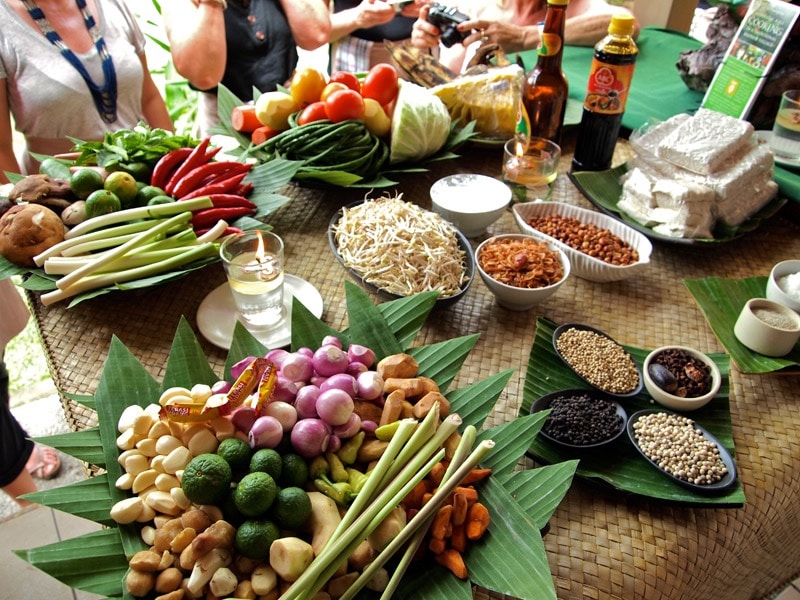The Paon Bali Cooking Class is much more than chopping, dicing and stir frying. Along with these basic cooking tasks and learning about tasty Balinese cuisine, it’s an enriching introduction to Balinese life and customs.
Ni Luh Made Puspawati, who asks to be called Puspa, and her husband, Wayan Subawa, offer cooking classes in their charming home just outside the town of Ubud. But, before getting started there are the preparations—a trip to Ubud’s bustling market where all manner of fruits and vegetables are for sale. Some women sit on the ground with their produce spread out on blankets while others have stands to display their merchandise. It’s crowded and chaotic but fascinating.
To westerners, much of the produce is exotic and unknown. Our market guide, Nyoman Murdiono, lets us taste mangosteen, durian, jackfruit, hairy fruit (rambutan) and more. He leads us to the knife section and explains the different kinds of tools needed in the Balinese kitchen. Next, the spices. My classmates and I make a few key purchases.
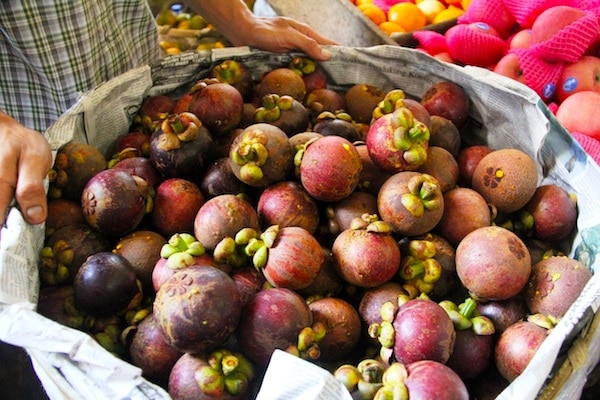
On the way back home where cooking will get underway, we stop at the rice paddies near the village. “Each family has a rice paddy,” Murdiono explained. “If a village has 150 families, it will have 150 rice paddies. He plucks a shoot of rice and shows us where a grain is growing. We walk on to the village school where he explains the Balinese educational system as children eagerly pose for photos.
At the family home, Subawa, the man of the house, greets us. “You are a guest in my home,” he says as he offers each of us a welcome drink, refreshing lime juice. A Balinese home is made of several sections, each an individual structure. The complex always includes the family temple which faces east. Most Balinese are devout Hindus, and religion plays an important role in their lives, including their culinary traditions. Religious ceremonies and festivals which involve special foods are prevalent. Subawa shows us the building where he and his wife sleep, and the rocks adjacent to the entrance marking the spots where the placentas of their children are buried. Placenta burial is very important to the Balinese who believe the spirit of the placenta will ensure that children remember their parents.
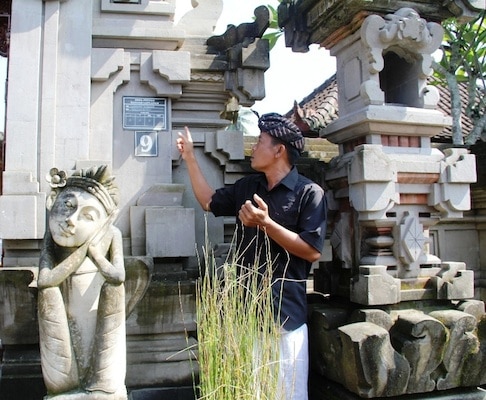
He then ushers us to the outdoor kitchen overlooking the jungle where Puspa, our effervescent and ever smiling teacher, and several assistants take over. We will be preparing Balinese – not Indonesian – dishes, Puspa, explains. Bali is one of 13,466 islands that make up the Indonesian archipelago. Its cuisine is influenced by both China and India. A typical meal consists of many different dishes, always accompanied by rice. The food is pungent and spicy enriched with the flavors of fresh ginger, raw chilies, shrimp paste, palm sugar, and tamarind. During our morning session, we prepared eight different dishes, all of which we savor for lunch, the finale of our cooking class.
Cleanliness is foremost at Puspa’s school. We were directed to wash our hands several times, and given plastic gloves for some of the tasks. Most of the prep had been done prior, so we were spared the chopping and dicing. But we did blend and sauté under Puspa’s watchful eye. We all took turns using a “Balinese blender”—a bowl filled with ingredients which you mash and blend with a long pole.
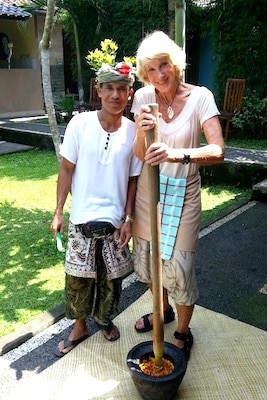
Most of our dishes were cooked in coconut oil, which we learned “is basic to Balinese cooking.” In country villages people make their own coconut oil. Puspa also makes her own and she demonstrated how it is made on an outdoor fire, a lengthy multi-step process. But the result, she assured us, is much better than store bought oil. Coconut oil has other uses, too. The Balinese rub babies’ fingers with the oil, use it for massages and put it on mosquito bites.
Another basic is the yellow sauce which is called for in numerous recipes. We whipped it up in no time as all the chopping had been done before our arrival. We were given copies of all the recipes we learned but this one I was most interested in trying when I returned home. Garlic, galangal, fresh turmeric, two different kinds of hot chilies, lemon grass and shrimp paste are among the ingredients. I found most of these at an Asian store, with the exception of fresh turmeric for which I had to substitute turmeric powder. This is a sauce with a punch that adds the magic touch to Balinese cuisine. Making the sauce at home was time consuming; however, the recipe makes a large quantity which can be kept in the refrigerator for two to three weeks for reuse. It’s the key ingredient in Chicken in Coconut Cream, a tasty concoction which I made for guests who loved it. Steamed Fish in Banana Leaves and Coconut and Snake Bean Salad were two other recipes that called for the yellow sauce.
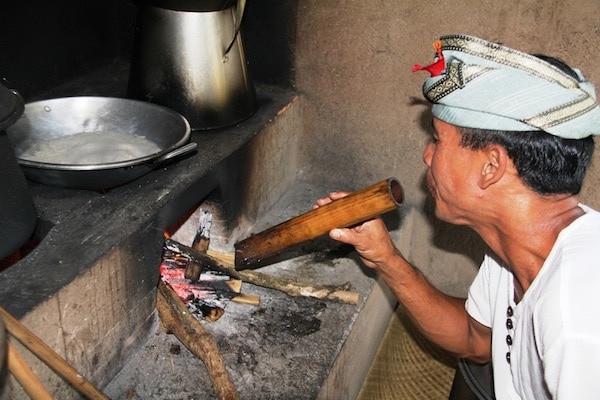
Peanut sauce is another frequent ingredient in Balinese cuisine and is much easier to make than the yellow. One of my favorite dishes was Vegetables in Peanut Sauce. You can use any veggies of your choice. Pusba’s version included a combination of cabbage, string beans, cucumber and tofu. This sauce is also used in Chicken Sate (minced chicken grilled on bamboo sticks). If you can’t find bamboo sticks just use ice cream sticks or chop sticks, our teacher suggested.
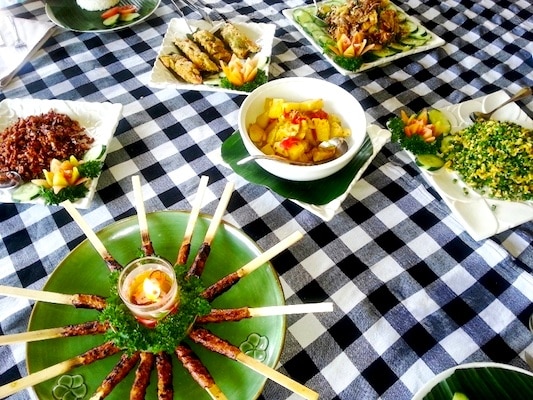
But, almost everyone’s favorite dish was Deep Fried Tempe (an Indonesian soybean variant) in Sweet Soy Sauce. No yellow or peanut sauces in this recipe, instead the ingredients are 10 red chilies and five kaffir lime leaves. I’m not a huge tofu fan, but this was terrific.
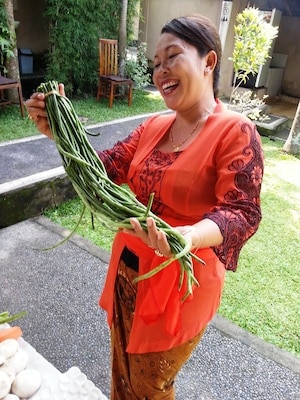
Clear Mushroom and Vegetable Soup was our first course, while Boiled Banana in Palm Sugar Syrup was the finale—all delicious and beautifully presented.
Pusba’s enthusiasm for Bali and its food is a key element in her class. Her course is fun, entertaining, educational—and delicious. She started her home cooking school five years ago and is proud to announce that on Trip Advisor it’s the number two cooking school in Ubud, but the third tourist attraction in the town.
“People are interested in traditional food,” she said. “I love to invite people to my house. I love to show Balinese life.”
Paon Bali Cooking Class
Laplapan Village
Ubud Gianyar, Bali, Indonesia
+62 81 337 939095
Contact: Wayan Subawa

